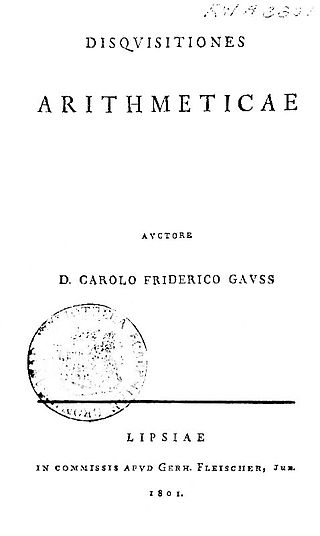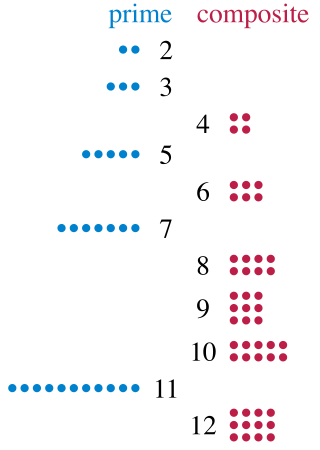
In mathematics, the fundamental theorem of arithmetic, also called the unique factorization theorem and prime factorization theorem, states that every integer greater than 1 can be represented uniquely as a product of prime numbers, up to the order of the factors. For example,
In mathematics, the greatest common divisor (GCD), also known as greatest common factor (GCF), of two or more integers, which are not all zero, is the largest positive integer that divides each of the integers. For two integers x, y, the greatest common divisor of x and y is denoted . For example, the GCD of 8 and 12 is 4, that is, gcd(8, 12) = 4.

In mathematics, modular arithmetic is a system of arithmetic for integers, where numbers "wrap around" when reaching a certain value, called the modulus. The modern approach to modular arithmetic was developed by Carl Friedrich Gauss in his book Disquisitiones Arithmeticae, published in 1801.

A prime number is a natural number greater than 1 that is not a product of two smaller natural numbers. A natural number greater than 1 that is not prime is called a composite number. For example, 5 is prime because the only ways of writing it as a product, 1 × 5 or 5 × 1, involve 5 itself. However, 4 is composite because it is a product (2 × 2) in which both numbers are smaller than 4. Primes are central in number theory because of the fundamental theorem of arithmetic: every natural number greater than 1 is either a prime itself or can be factorized as a product of primes that is unique up to their order.

In mathematics, a square-free integer (or squarefree integer) is an integer which is divisible by no square number other than 1. That is, its prime factorization has exactly one factor for each prime that appears in it. For example, 10 = 2 ⋅ 5 is square-free, but 18 = 2 ⋅ 3 ⋅ 3 is not, because 18 is divisible by 9 = 32. The smallest positive square-free numbers are

In number theory, a Gaussian integer is a complex number whose real and imaginary parts are both integers. The Gaussian integers, with ordinary addition and multiplication of complex numbers, form an integral domain, usually written as or

In mathematics, a divisor of an integer also called a factor of is an integer that may be multiplied by some integer to produce In this case, one also says that is a multiple of An integer is divisible or evenly divisible by another integer if is a divisor of ; this implies dividing by leaves no remainder.

In number theory, Euler's totient function counts the positive integers up to a given integer n that are relatively prime to n. It is written using the Greek letter phi as or , and may also be called Euler's phi function. In other words, it is the number of integers k in the range 1 ≤ k ≤ n for which the greatest common divisor gcd(n, k) is equal to 1. The integers k of this form are sometimes referred to as totatives of n.

A composite number is a positive integer that can be formed by multiplying two smaller positive integers. Accordingly it is a positive integer that has at least one divisor other than 1 and itself. Every positive integer is composite, prime, or the unit 1, so the composite numbers are exactly the numbers that are not prime and not a unit. E.g., the integer 14 is a composite number because it is the product of the two smaller integers 2 × 7 –ut the integers 2 and 3 are not because each can only be divided by one and itself.
A highly composite number is a positive integer that has more divisors than all smaller positive integers. A related concept is that of a largely composite number, a positive integer that has at least as many divisors as all smaller positive integers. The name can be somewhat misleading, as the first two highly composite numbers are not actually composite numbers; however, all further terms are.
The tables contain the prime factorization of the natural numbers from 1 to 1000.
72 (seventy-two) is the natural number following 71 and preceding 73. It is half a gross or six dozen.
58 (fifty-eight) is the natural number following 57 and preceding 59.

120 is the natural number following 119 and preceding 121. It is five sixths of a gross, or ten dozens.
200 is the natural number following 199 and preceding 201.

A powerful number is a positive integer m such that for every prime number p dividing m, p2 also divides m. Equivalently, a powerful number is the product of a square and a cube, that is, a number m of the form m = a2b3, where a and b are positive integers. Powerful numbers are also known as squareful, square-full, or 2-full. Paul Erdős and George Szekeres studied such numbers and Solomon W. Golomb named such numbers powerful.
1728 is the natural number following 1727 and preceding 1729. It is a dozen gross, or one great gross. It is also the number of cubic inches in a cubic foot.
Euler's factorization method is a technique for factoring a number by writing it as a sum of two squares in two different ways. For example the number can be written as or as and Euler's method gives the factorization .
The number 4,294,967,295 is a whole number equal to 232 − 1. It is a perfect totient number, meaning it is equal to the sum of its iterated totients. It follows 4,294,967,294 and precedes 4,294,967,296. It has a factorization of .
This is a glossary of concepts and results in number theory, a field of mathematics. Concepts and results in arithmetic geometry and diophantine geometry can be found in Glossary of arithmetic and diophantine geometry.











